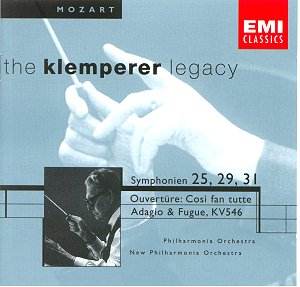Wolfgang Amadeus MOZART (1756 - 1791)
Overture Cosi fan tutte. K588* 4.31
Symphony No 25 in G Minor. K183 19.15
Adagio & Fugue. K546 8.36
Symphony No 29 in A. K201* 25.14
Symphony No 31 in D "Paris" 18.47
 Philharmonia Orchestra,
New Philharmonia Orchestra* conductor Otto Klemperer
Philharmonia Orchestra,
New Philharmonia Orchestra* conductor Otto Klemperer
 Recorded Oct 1964
(Cosi); March 1956 (K546);Sept 1965 (No 29); Oct 1963 (No 31); Abbey
Road Studios. July 1956 ( No 25). Kingsway Hall EMI. The Klemperer
Legacy. CDM 5 67331 2 [76.57]
Recorded Oct 1964
(Cosi); March 1956 (K546);Sept 1965 (No 29); Oct 1963 (No 31); Abbey
Road Studios. July 1956 ( No 25). Kingsway Hall EMI. The Klemperer
Legacy. CDM 5 67331 2 [76.57]

This new CD is part of a series "The Klemperer Legacy" from EMI that includes
four Mozart discs. Two of them have reached me (see companion review). All
have been remastered using state of the art 24 bit technology.
The Philharmonia Orchestra (and its alter ego after adding 'New') of the
1950's and 60's was, under Klemperer, a splendid unit. These recordings are
from that period when Klemperer himself was in his seventies (b 1885) and
an incapacitated septuagenarian at that. The standard of the music they produced
was quite magnificent.
The opening item on the disc is the overture to Cosi fan tutte and
my instant reaction on hearing the opening chords was of dismay - a feeling
which quickly went, I must add. The feeling was prompted by listening with
today's ears to an orchestral performance of nearly forty years ago. Today's
Mozart (and I am not referring to the 'authentic' or period instrument schools)
is so much 'leaner' that the ears and mind have to adjust to the bigger
orchestra. Once you have done that, you then sit back and enjoy it. Despite
its size, the unity and cohesion of the Philharmonia makes it sound like
a chamber orchestra.
Symphony No 25 - the earliest recorded (1956), a fact which is barely evident
on disc - is notable for some dazzling string playing in the opening movement
and intimate warmth of the Andante. The Trio section shows
how integrated the woodwinds were - a comment that could be repeated time
after time - and the closing Allegro showed the benefit of Klemperer's usual
splitting of violins.
The radiant No 29 in A is deservedly a well-loved work which cannot fail
to please. It is difficult to imagine that a frail old man of 80 could guide
a performance of such charm and grace. All the inner parts are heard in detail
in an utterly captivating reading. The opening Allegro -
unhurried - leads to the Andante with oboes and horns contributing
tellingly. The charming Trio section leading to the Finale,
played with dash and elan. Again the interplay between the parts reminded
one of a chamber group.
The 'Paris' (No 31) is, unusually, a three movement Symphony. The
forces written for included trumpets and clarinets, and their use brings
added variety - the trumpets notably in the opening Allegro Assai . The
middle movement Andantino is a gentle waltz like rhythm has
some lovely wind playing against hushed strings. A lively, largely contrapuntal
Allegro follows.
Completing the disc is Adagio and Fugue K546. This is a transcription of
a two piano Fugue to which Mozart added an adagio. It proves to be a forward
looking, rather severe, full-blooded work with much use made of the brooding
lower strings.
The recordings? In their day Walter Legge and his colleagues followed the
basic tenets of getting the balance right and a good recording would follow.
It worked then and today's transcriptions show how well they knew their business.
A warm welcome back to the catalogue of some music making that was highly
regarded in its day. Is today equally its day? I think so. What we have here
is timeless music making - even if it might sound old fashioned to some ears
- that deserves to be listened to again and again.
Reviewer
Harry Downey


![]()